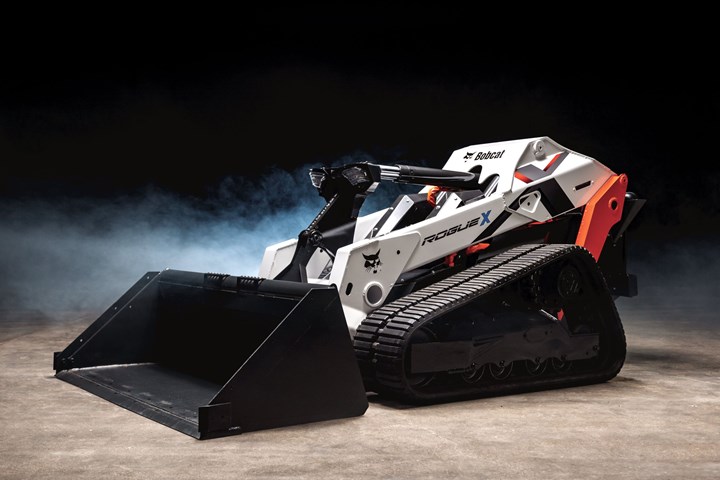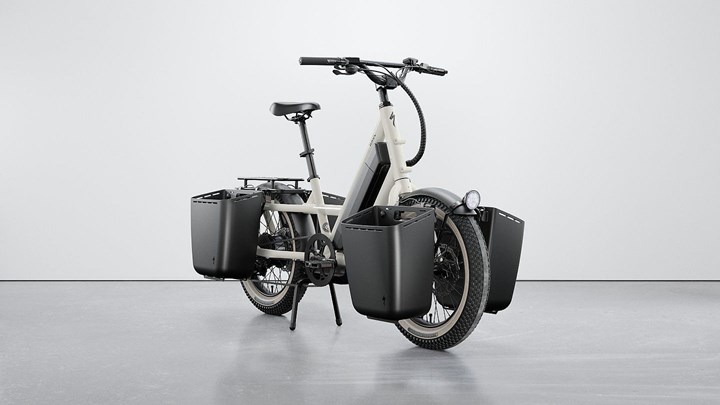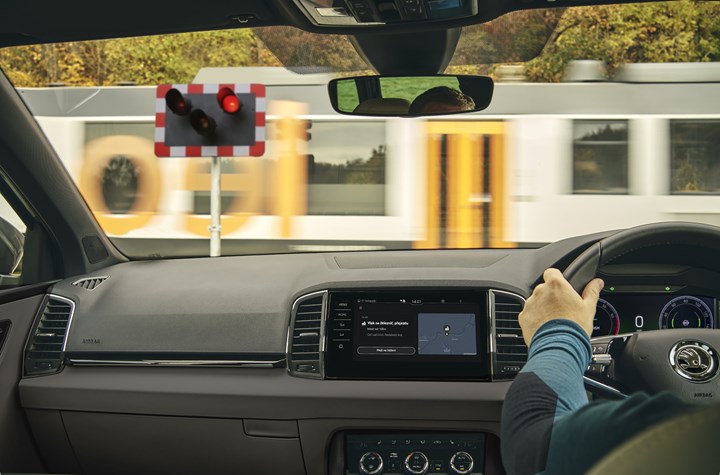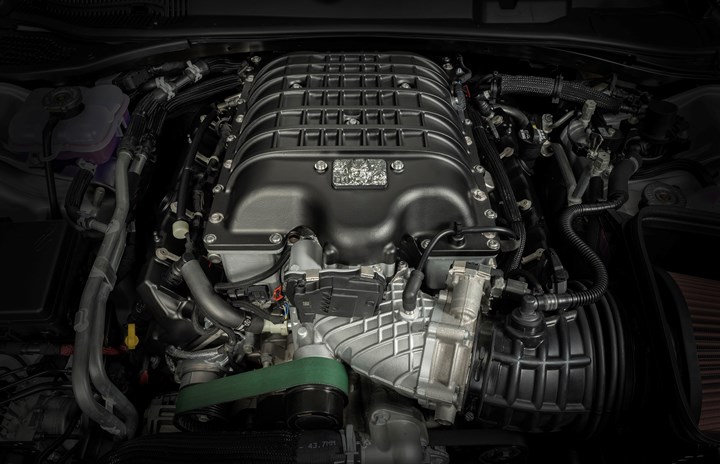on Autonomy for work sites, a car-replacing bike, & why charging a battery is like inflating a balloon
A concept Bobcat AV. . .an electric bike that can haul cargo. . .what’s important for carbon neutrality. . .an app to prevent car-train accidents. . .how to understand EV charging rates (simply). . .VW ID. 4 considered. . .what do EV buyers really consider. . .Dodge 1,025-hp engine
Bobcat Going Electric & (Eventually) Autonomous

What’s missing from this loader concept vehicle? (Image: Bobcat)
Bobcat builds vehicles including compact loaders, excavators, tractors, utility products, and mowers for agricultural, construction, forestry, and other industries—the smaller machines that you see on various job sites rather than the giant yellow or green ones.
Last week it introduced what it says is the “world’s first all-electric skid-steer loader.”
- Joel Honeyman, Doosan Bobcat vice president of global innovation:
“As the inventor of the original skid-steer loader, we are excited to take the machine that created the industry and reinvent it all over again.”
The S7X is powered by a 60.5-kWh lithium-ion battery that powers the vehicle for up to eight hours.
One interesting aspect of the development of the vehicle is that Bobcat worked with Moog Inc., a developer of precision motion control systems. That tech is arguably more related to aircraft rather than something moving stuff on the ground.
Going Remote
But what may be more interesting is a concept vehicle that it introduced: the RogueX.
Ostensibly a track loader, the RogueX, which offers functionality including vertical-path and radial-path lift capabilities, is missing something: a cab.
Yes, an electric, autonomous vehicle.
- Honeyman:
“RogueX was concepted with consideration for the worksite of the future and how a customer’s needs may evolve—with a focus on ease of use, remote operations, autonomous functionality, sustainable operations and features that allow operators to accomplish more with one machine.”
Hmm. . .
While it is still a concept, this is another example as why autonomous technology may have a more useful near-term future than replacing cab drivers.
///
Cargo-Carrying Two-Wheeler Launched

An electric bike with sufficient capacity to make a run to Costco. (Image: Specialized)
A car too much and a commuter bike not enough?
Bicycle manufacturer Specialized says it has an answer in its just-released Globe Haul ST.
Its a pedal-assist cargo e-bike—meaning the rider has to pedal to get motorized assistance--that has a top speed of 28 mph and provides a range, with its 7.72 kWh replaceable battery, of up to 60 miles and can be setup—as shown in that picture—to provide a cargo capacity of 419 pounds.
Recharging can take 7+ hours from a standard AC outlet.
The bike frame is an aluminum alloy; the fork is steel.
The frame comes in one size and is available in two colors (Satin Obsidian or Gloss White Mountains).
MSRP? $2,700.
///
What Matters to Driving Down Net Carbon Intensity
Shell released its “Energy Transition Progress Report 2022” and, not surprisingly, as Wael Sawan, Shell CEO, put it: “In this report, we show the progress we have made towards becoming a net-zero emissions energy business by 2050, as we continue to supply the vital energy the world needs during a time of great volatility.”
Also not surprisingly, the company is taking a portfolio approach to energy, including electricity, hydrogen, biofuels, and conventional fuels.
So while you might conclude this is a shrug, there are a couple of interesting things found in the report:
- “We estimate that our oil production peaked in 2019. In 2022, our crude oil and natural gas liquids production available for sale was 13% lower than in the previous year.”
While you might think that this means that the electricity, hydrogen and biofuels are a big driver for this—and make no mistake, the use of alternatives does reduce the demand for oil—turns out the reason for the drop:
“This larger than usual decline was mainly driven by portfolio changes, including the sale of our Permian business in late 2021 and the derecognition of volumes related to Sakhalin in Russia.”
The Permian sale is of 225,000 net acres of land and production of about 175,000 barrels equivalent per day. ConocoPhillips bought it. For $9.5 billion. Cash.
So it is Shell’s peak production it is referring to.
Still, there are some serious alternative fuel undertakings, including: “Our single biggest investment was the $1.6 billion acquisition of Sprng Energy, a solar and wind platform in India. It added 2.3 GW to our renewable generation capacity and 7.5 GW to our pipeline of future products” and “In July 2022, we took the final investment decision to build Holland Hydrogen 1 in the Netherlands, which will be Europe’s largest renewable hydrogen plant once operational.”
But know this
Shell put in its report:
- “The biggest driver for reducing our net carbon intensity is increasing the sales of and demand for low-carbon energy.”
All of the technology developments notwithstanding, supply and demand still matter.
///
Helpful—Critical—Info Piloted by Škoda

Škoda has developed an app that alerts drivers of on-coming trains. (Image: Škoda)
OEMs across the board all want to stuff screens with apps, ideally in order to be able to derive digital revenue. While not exactly rising to the level of “bloatware” that is found on PCs, it still causes a raised eyebrow.
Škoda, a Volkswagen Group company that sells vehicles in Europe, is trialing a new tech that can be highly beneficial: train warning software.
It is piloting it with Czech railway company Leo Express.
The train company provides real-time train location information to the cloud. Then Škoda communicates information about the location to vehicles using its Traffication app when those vehicles are near a railway crossing.
Warnings about the approaching train are shown on the screen and audibly announced.
Serious Stats
According to the U.S. Federal Railroad Administration Office of Safety Analysis, in 2022 there were a total of 9,770 accidents/incidents. That led to 978 fatalities—10%.
While that may seem to be a comparatively small number, given a choice between being able to order a coffee from your infotainment screen and having a loved one (or self) getting a warning of an impending collision. . . .
Credit to Škoda for a useful app.
///
Batteries Like Balloons
Here’s a useful, nontechnical analogy about recharging electric vehicle batteries from How To Buy an Affordable Electric Car by Matt DeLorenzo:
“Recharging a battery is like blowing up a balloon. It takes a lot of effort to get those first few puffs in, then it’s relatively easy to blow up, and then gets harder when it’s near full. As you reach capacity, the air inside a balloon pushes back. The same theory applies to a battery. It requires a lot of energy to start charging a fully depleted battery, gets easier between 20 and 80 percent capacity, and then gets harder again for that last 20 percent of charge.”
Which goes to explain why OEMs generally note how quickly their vehicles can be recharged from 20 to 80%, not 0 to 100%.
///2023 VW ID.4 Pro AWD

The VW ID.4 electric compact crossover. Based on the MEB platform, VW builds the global vehicle in Germany, China, and. . . VW’s Chattanooga, Tennessee, assembly facility. (Image: VW)
Here’s something to know about the Volkswagen ID.4, the company’s first purpose-built electric SUV available in the U.S. market (through model years 2015 to 2019 the VW e-Golf, a hatch, was available in the U.S. market, though it was essentially a Golf with its propulsion system swapped out, so it was not purpose-built, nor was in an SUV) that goes to the point of how serious the company is about engineering this vehicle:
The company notes that its 82-kWh battery—which provides the ID.4 AWD Pro (and AWD Pro S) with an EPA-estimated range of 255 miles—has a mass of 1,047 pounds. Not the sort of thing that you usually find EV OEMs mentioning.
But VW points out that about a fifth of that weight is accounted for by the aluminum housing—consisting of both extruded and pressure-cast components. And that housing is then bolted to the frame.
Relevance? It helps improve the overall rigidity of the vehicle. Yes, this SUV seems very solid. And by pointing out things like that it is clear that this is something that the VW engineers worked hard on.
Solid to Not
This fundamental solidity is a substantial contrast in the interior, which VW describes as “airy.” And it says the “dash panel appears to float.”
While someone walking up to the vehicle would think, say, “This is a nice looking compact ute,” and when up close, “Well done seats and storage.”
But then turning to the instrument panel and the controls on the driver’s armrest changes things up quite significantly, not so much, necessarily, as is the case with some vehicles, an effort to compete with Tesla as much as an apparent attempt to make one know that this isn’t simply an automobile but high-tech device.
Screens & Surfaces
That is, instead of a traditional gauge cluster embedded in the IP in the area behind the steering wheel there’s a five-inch color screen (the “ID.Cockpit”) mounted to the steering column. Think: smartphone in landscape mode providing numeric details of your drive. To the left, on the armrest, there are what seems to be the now-familiar switches to put down the power windows, but this is a four-door and there are two switches: you have to tap an area on touch-sensitive surface to make the switches operate either for the front or the back. It is not entirely clear whether this simplicity is borne of cleverness or cost-cutting.
Another somewhat unusual thing is the shift knob, which is, well, more of a knob that you turn in a rotary vertical motion than the knob on the end of a conventional shift lever that you move in a horizontal motion. One of the advantages of the aforementioned ID.Cockpit is said to be that it is always readily visible; I found that depending on my seating position and/or steering wheel position adjustment finding the shift knob to be a bit of an exercise.
Then there is the 12-inch touch-sensitive screen in the center of the IP—the “Discover Pro Max”—for your infotainment purposes. It is just above an inclined surface into which sliders for volume control and temperature adjustments are embedded; the ergonomics of trying to swipe a slider while driving are troubling at best.
Subjective But Substantive
While admittedly anecdotal, the IP execution provoked a completely unsolicited email from an ID.4 owner who wrote, in part, “the dashboard interface is so wonky and time consuming to navigate.” Guess what she won’t be buying again.
There is an evident attempt at minimalism in the interior execution, but if that style leads to a totally frustrated owner (who, by the way, works for a tech company, so its not like she isn’t cognizant of digital advances), there needs to be a rethinking.
One of the reasons why Herbert Diess lost his job as CEO of Volkswagen last year was reportedly related to the less-than-suitable performance of CARIAD, the company’s software organization.
Whether that’s true or not, it does lead to the notion that while vehicle manufacturers including VW have some excellent engineers who are well versed in things like structures and propulsion systems, the same level and number of those who are in the digital realm are still lacking. (And somehow the skillset and capabilities to develop apps and interfaces that are used by people who are holding the device a foot away from their face and not traveling at 75 mph seem different than those needed for automotive.)
As a vehicle, the ID.4 is well done.
As a tech device, well, wonky.
///
How Important Is “Green” For EV Buyers?
When it comes to electric vehicles, turns out that the answer to that question is “not very.”
Or so analysis by Predicta shows.
Analyzing information aggregated from the internet and then running it through an AI system the firm found that these are the topics that achieve the most mentions in reviews and assessments of EVs:
- Quality: 69%
- Value: 63%
- Driving performance: 56%
- Battery range: 53%
- Charging: 52%
- Environmental impact: 23%
- Display screen: 22%
- Driver-assist features: 20%
When display screens are just behind the environment by a single point, it seems that zero emissions probably aren’t what consumers are considering.
However. . .It could be a case of climate, emissions, pollution, sustainability, and green—all topics combined into the “Environmental impact” category go without saying.
Could be.
///
Dodge Turns It Up Nearly to 11 (1,025, actually)

Dodge Demon 170 engine: Definition of heavy-metal. Part of the “Last Call” for HEMIs. (Image: Dodge)
Consider these Dodge engine numbers:
- 2015: 707-hp Hellcat
- 2018: 840-hp Demon
- 2023: 1,025-hp Demon 170
And while there will continue to be performance developments from the brand, those will be predicated mainly on electric motors, not HEMI engines.
So the Demon 170 is something of a last hurrah. Or that should be HURRAH!
Something You Don’t Ordinarily Hear from the Head of a Brand
Tim Kuniskis, Dodge brand CEO, says this about the Dodge Challenger SRT Demon 170:
“To celebrate the end of the HEMI muscle-car era, we pulled off all the governors to reach a new level, a new benchmark of ‘factory-crazy’ production car performance.”
Typically, it is the sort of thing that would be produced as a one-off by tuners.
This engine and the car that is wrapped around it are being built by the company. More than one, but not many: production will be no more than 3,300 vehicles, with 3,000 for the U.S. and 300 for Canada.
Powertrain Stats
- The 6.2-liter V8 produces 1,025-hp @ 6,500 rpm and 945 lb-ft of torque @ 4,200 rpm on E85 ethanol blend. For those who choose E10, those numbers are 900 hp and 810 lb-ft. (What’s a few extra bucks at the pump for someone buying a car with an MSRP of $96,666?)
- There is a 3.0-liter supercharger with a 105-mm throttle body and 3.02-inch pulley. The boost pressure is 21.3 psi.
- The “SRT Power Chiller” reduces the air induction temperature by up to 45 degrees.
- High-flow fuel injectors are used. While this isn’t going to happen, to put the flow into context, know that they could provide 164 gallons per hour.
- Compared to the engine in the Hellcat Redeye Widebody, the aerospace-spec high-strength steel studs with steel inserts integrated into the aluminum cylinder head provide a 38% increase in clamping load.
And the Driveline
- The rear prop shaft is 30% stronger than that in the 2018 SRT Demon.
- The 240-mm rear axle features housings produced with hot isostatic pressing (HIP) to eliminate porosity.
- There are 43-spline rear half shafts.
No Surprise
0 to 60 for the 2023 Dodge Challenger SRT Demon 170: 1.66 seconds.
RELATED CONTENT
-
When Automated Production Turning is the Low-Cost Option
For the right parts, or families of parts, an automated CNC turning cell is simply the least expensive way to produce high-quality parts. Here’s why.
-
Jeeps Modified for Moab
On Easter morning in Moab, Utah, when the population of that exceedingly-hard-to-get-to town in one of the most beautiful settings on Earth has more than doubled, some people won’t be hunting for Easter eggs, but will be trying to get a good look at one of the vehicles six that Jeep has prepared for real-life, fast-feedback from the assembled at the annual Easter Jeep Safari.
-
Engineering the 2019 Jeep Cherokee
The Jeep Cherokee, which was launched in its current manifestation as a model year 2014 vehicle, and which has just undergone a major refresh for MY 2019, is nothing if not a solid success.


.jpg;width=70;height=70;mode=crop)






